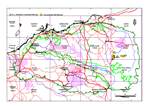Click on images
to enlarge



Photographer: S. van Leeuwen

Photographer: B.R. Maslin

Photographer: D. Murphy

Photographer: J. Maslin

Photographer: M.W. McDonald
, BRM 8680, lab photo by Fiona McCallum ADJUSTED_sml.jpg)
Seed from one herbarium voucher. Scale in mm. Photographer: F. McCallum.
Botanical name
Acacia aphanoclada Maslin, Nuytsia 8: 290, figs 2A-D (1992)
Common name
Nullagine Ghost Wattle
Description
Wispy, glabrous, shrubs 3-6 m high, single-stemmed or occasionally with up to 3 main stems from ground level, stems spindly (1-2 cm diameter at breast height), crown foliage sparse and concentrated at ends of the very slender, pruinose branchlets which tend to droop. Bark grey-brown to reddish grey or light bronze, smooth. Branchlets pruinose. Stipules more or less spiny although sometimes absent, small. Phyllodes narrowly linear, ±terete near base otherwise flat to compressed, 20-45 cm long, usually 1.5-2 (-3) mm wide but on sucker regrowth they may reach up to 10 mm across, pendulous or almost so, not rigid, shallowly incurved at least near the base, grey-green to sub-glaucous or glaucous, sometimes green; midrib not prominent; apex narrowed into a sometimes spiny tip (the points normally break off with age). Inflorescences racemose, occasionally simple, racemes 5-9 (-18) cm long; peduncles mostly twinned, 10-20 mm long, slender; heads globular, 10-11 mm diameter (fresh), 7-9 mm when dry, golden, densely 70-90-flowered. Flowers 5-merous; sepals free, narrowly spathulate. Pods narrowly oblong, straight-edged or constricted between seeds, 3-7 cm long, 6-8 mm wide, ±firmly chartaceous, pruinose at least when young. Seeds ±longitudinal in the pods, obloid to widely ovoid or almost globose, 4-5 mm long, ±dull, brown, often yellowish near pleurogram.
Characteristic features
Wispy, tall, single-stemmed shrubs with inconsequential crown of sparse foliage and very slender, pruinose branchlets that tend to droop. Stipules small and spiny although sometimes absent. Phyllodes very long and slender (mostly 20-45 cm x 1.5-2 mm), flat with a single, obscure midrib. Flower heads usually arranged in short racemes 5-9 (-18) cm long. Pods rather papery and pruinose at least when young.
Distribution and ecology
Acacia aphanoclada is an uncommon species which is known only from the vicinity of Nullagine in the Pilbara region of northwest Western Australia. It grows on rocky hills (of mostly the Mosquito Creek geological sediment and conglomerate) in spinifex country with scattered Eucalyptus spp. and Acacia spp. It does not form dense populations but is often reasonably common in the places where it occurs. On account of their very wispy growth form plants of this species may be difficult to see, despite the fact that they grow to about 6 m tall (they are often most readily observed when growing on the crest of ridges and silhouetted against the sky).
Flowering and fruiting period
Flowers from August to October. Pods with mature seeds have been collected in October and November and may be present with the flowers.
Variation
Nullagine Ghost Wattle is typically single-stemmed, however, following fire plants may regenerate with up to three main stems from the base.
Affinities
This species is a member of the 'A. victoriae group' (see Maslin 1992 for discussion) but is not likely to be confused with any of its relatives on account of its distinctive wispy, spindly growth form and its very long and slender phyllodes. Members of the 'A. victoriae group' which occur in the Pilbara are: A. aphanoclada, A. cuspidifolia, A. glaucocaesia, A. robeorum, A. synchronicia and A. victoriae. A hybrid between A. aphanoclada and A. pyrifolia (A. aphanoclada x pyrifolia var. pyrifolia) occurs near Nullagine. This hybrid has the spindly growth form of A. aphanoclada but its phyllodes are much shorter and broader. Acacia pyrifolia is closely related to the A. victoriae group of species.
Plants of A. orthocarpa which grow near Nullagine (and elsewhere in the Pilbara) may superficially resemble A. aphanoclada in having a similar growth form and long, slender phyllodes. Upon close inspection, however, A. orthocarpa is readily distinguished by its cylindrical, simple inflorescences (not round heads arranged in racemes as in A. aphanoclada), nerveless phyllodes which are covered with minute white dots (observe at x10 magnification or higher) and its woody pods.
Conservation status
Acacia aphanoclada is classified as a Priority 1 species on the Department of Environment and Conservation's Declared Rare and Priority Flora List.
Origin of name
The botanical name is derived from the Greek aphanes (unseen, invisible, obscure) and klados (branch), in reference to the characteristic spindly, wispy growth habit of this species. Similarly, the common name is in allusion to the growth habit (and also the area where the species grows).
References
Maslin, B.R. (1992). Acacia Miscellany 6. A review of Acacia victoriae and related species (Leguminosae: Mimosoideae: Section Phyllodineae). Nuytsia 8: 285-309.
